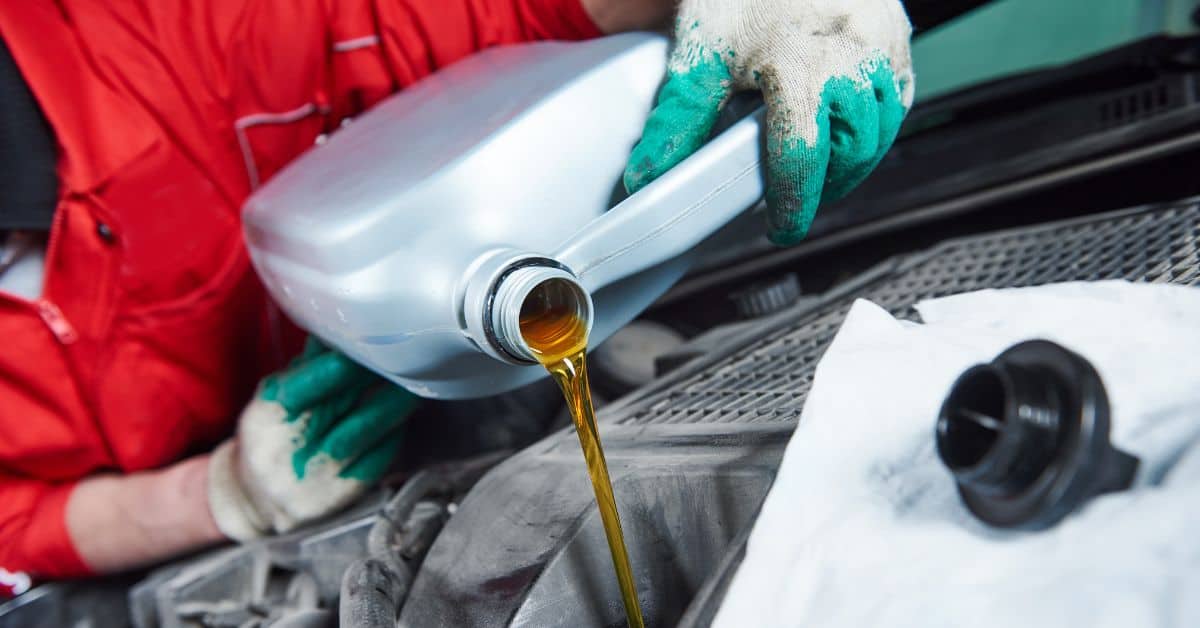Oil Change and Oil Filter Changes: 12 Essential Things To Know
Ever wonder about the heartbeat of your car? Regular oil and oil filter changes are its lifeline. Delve into why these simple maintenance steps can dictate your vehicle’s health and longevity.

Why Are Oil And Oil Filter Changes Important?
Regular oil and filter changes are vital for peak vehicle performance. Engine oil reduces wear by lubricating moving parts but degrades over time, accumulating impurities.
A saturated oil filter fails to catch these contaminants. Neglecting these changes risks engine damage, reduced fuel efficiency, and a shorter vehicle lifespan.

“Drive Past Myths: Get the Real Deal on Car Buying!”
🚘 Uncover 13 Car Buying Misconceptions with Our FREE Newsletter!
Plus you will get our quick tips, expert advice, and myth-busting insights delivered straight to your inbox.
Subscribe now and make informed decisions without the detours.
“Experts Hate This! Learn the Car Buying Secrets They Don’t Want You to Know. Free Subscription!”
Keep reading for expert advice so you don’t get ripped off when getting an oil or oil filter change.
Understanding Oil Change
Regularly changing the oil in a vehicle is one of the most important maintenance tasks to keep a car running smoothly.
Motor oil lubricates the engine’s moving parts and helps to prevent wear and tear. Over time, motor oil can break down and lose its effectiveness. This can cause damage to the engine and reduce fuel efficiency.
The frequency of oil changes varies depending on the make and model of the vehicle, as well as the type of oil used.
Conventional motor oil typically needs to be changed every 3,000 to 5,000 miles, while synthetic oil can last up to 10,000 miles or more. It is important to follow the manufacturer’s recommendations for oil change intervals.
The old oil is drained from the engine during an oil change and replaced with fresh oil. The oil filter is also replaced to remove any contaminants in the oil.
The oil filter should be changed at every oil change to protect the engine from harmful particles.
In addition to changing the oil and oil filter, a mechanic may visually inspect the vehicle to identify potential issues.
This can include checking the air filter, inspecting the brakes, and checking the fluid levels.
Regular oil changes are essential to keeping a vehicle running smoothly and extending its lifespan.
By following the manufacturer’s recommendations for oil change intervals and having regular inspections, car owners can ensure that their vehicle is well-maintained and running at its best.
Importance of Regular Oil Change
Regular oil changes are essential for maintaining the health and longevity of a vehicle’s engine.
Clean oil helps to lubricate the engine’s moving parts, reducing friction and wear. It also helps to cool the engine by carrying heat away from the combustion chamber.
Over time, however, oil can become contaminated with dirt, debris, and other contaminants, reducing its effectiveness and potentially causing damage to the engine.
By changing the oil and oil filter at regular intervals, drivers can ensure that their engine is running smoothly and efficiently.
Most manufacturers recommend changing the oil every 5,000 to 7,500 miles, or every six months, whichever comes first.
However, this can vary depending on the make and model of the vehicle, as well as driving conditions and habits.
Regular oil changes can provide a number of benefits, including improved engine performance, increased fuel efficiency, and extended engine life.
Clean oil helps to reduce engine deposits and sludge, which can cause engine wear and reduce fuel economy. It also helps to maintain proper oil pressure, which is essential for proper engine function.
In addition to these benefits, regular oil changes can also help to reduce harmful emissions and improve air quality.
Clean oil reduces the amount of harmful pollutants released into the environment, helping protect the health of both people and the planet.
Overall, regular oil changes are an important part of vehicle maintenance that can help to keep engines running smoothly and efficiently.
By following manufacturer recommendations and changing the oil and oil filter regularly, drivers can help ensure that their vehicle is performing at its best and is safe and reliable on the road.

Oil Change Process
Performing an oil change is an essential part of vehicle maintenance. It helps to ensure that the engine runs smoothly and efficiently. Here are the steps to follow when changing your oil:
Draining Old Oil
- Park the vehicle on a level surface and engage the parking brake.
- Open the hood and locate the oil filter and oil pan.
- Place a drain pan under the oil pan.
- Remove the oil drain plug using a wrench.
- Allow the old oil to drain completely into the drain pan.
- Once the oil has drained, replace the oil drain plug and tighten it with a wrench.
Replacing Oil Filter
- Locate the oil filter and remove it using an oil filter wrench.
- Take note of the orientation of the old filter and compare it to the replacement filter.
- Apply a small amount of new oil to the new filter’s gasket.
- Install the new filter and tighten it by hand.
- Double-check that the filter is properly installed and tightened.
Adding New Oil
- Refer to the owner’s manual to determine the correct type and amount of oil needed.
- Remove the oil filler cap.
- Insert a funnel into the oil filler hole.
- Slowly pour in the new oil.
- Use a dipstick to check the oil level.
- Replace the oil filler cap and tighten it.
Performing an oil change is a straightforward process that anyone can do with basic mechanical skills.
It is recommended to change the oil every 5,000 miles or as recommended by the vehicle manufacturer.
By following these steps, you can help ensure the longevity and performance of your vehicle’s engine.
Types of Motor Oil
There are a few different types to choose from when it comes to motor oil.
Each type has its own unique properties and is designed to meet specific needs. Here are the three main types of motor oil:
Synthetic Oil
Synthetic oil is a type of motor oil that is made from chemical compounds rather than crude oil.
It is designed to provide better performance and protection than conventional oil.
Synthetic oil is more expensive than conventional oil, but it lasts longer and can help improve fuel efficiency.
Conventional Oil
Conventional oil is the most common type of motor oil. It is made from crude oil and is designed to provide basic engine protection.
Conventional oil is less expensive than synthetic oil but needs to be changed more frequently.
High Mileage Oil
High mileage oil is designed for cars with more than 75,000 miles on the odometer.
It contains special additives that help reduce oil consumption, prevent leaks, and reduce engine wear. High mileage oil is available in both synthetic and conventional varieties.
When choosing a motor oil, it’s important to consider your vehicle’s needs. Synthetic oil may be the best choice if you have a newer car or want to improve fuel efficiency.
Conventional oil may be a better option if you have an older car or are on a tight budget. And if your car has high mileage, high-mileage oil can help keep it running smoothly.
Choosing the Right Oil for Your Vehicle
Choosing the right oil for your vehicle is crucial to maintaining its performance and longevity.
With so many options available, deciding which type of oil is best for your car can be overwhelming.
Here are a few factors to consider when selecting the right oil for your vehicle:
1. Viscosity
Viscosity is the most important factor to consider when choosing the right oil for your vehicle. It refers to the oil’s thickness or resistance to flow.
The viscosity rating is usually marked on the oil container with two numbers, such as 5W-30 or 10W-40.
The first indicates the oil’s viscosity in cold temperatures, while the second indicates its viscosity in hot temperatures.
Choosing an oil with the viscosity rating recommended by the vehicle manufacturer is important. Using the wrong viscosity oil can cause engine damage and reduce performance.
2. Type of Oil
There are three main types of oil: conventional, synthetic, and synthetic blend. Conventional oil is the most basic type of oil and is suitable for most vehicles.
Synthetic oil is more expensive but offers better performance and protection in extreme temperatures.
Synthetic blend oil is a combination of conventional and synthetic oils and offers some of the benefits of both.
The type of oil you choose depends on your driving habits, the age and condition of your vehicle, and the manufacturer’s recommendations.
3. Additives
Oil additives are chemicals added to the oil to improve its performance and protect the engine. Some common additives include detergents, anti-wear agents, and friction modifiers.
Choosing an oil with the right additives for your vehicle is important. For example, if you drive an older vehicle with high mileage, you may want to choose an oil with additives that protect against engine wear and reduce oil consumption.
4. Brand
Choosing a reputable brand of oil is also important. Brands that meet industry standards and have a good reputation for quality and performance are more likely to provide the protection your vehicle needs.
In summary, choosing the right oil for your vehicle involves considering factors such as viscosity, type of oil, additives, and brand.
It is important to follow the manufacturer’s recommendations and choose a high-quality oil that provides the protection your vehicle needs.
Oil Quality Video (Full Synthetic Oil)
I really like this guy’s YouTube channel. In this video, he pairs different motor oil brands together and tests and ranks them. I thought you might enjoy watching it to learn a bit more.
Signs Your Vehicle Needs an Oil Change
Regular oil changes are essential for maintaining the health and longevity of your vehicle’s engine.
Over time, engine oil becomes contaminated with dirt, debris, and other particles, which can cause damage to the engine if left unchecked. Here are some signs that your vehicle may be due for an oil change:
- Dashboard warning light: Many modern vehicles are equipped with a warning light indicating when it’s time for an oil change. If this light comes on, it’s important to have your oil changed as soon as possible to prevent damage to your engine.
- Unusual engine noises: If you notice unusual noises coming from your engine, such as knocking or grinding sounds, it may be a sign that your oil is dirty or low. This can cause increased friction between engine components, leading to damage over time.
- Dirty or grimy oil: Checking your oil regularly can give you a good indication of whether it’s time for a change. If your oil appears dirty or grimy, it’s likely time for a change. Clean oil should be a clear, amber color.
- Low oil level: If your oil level is low, it’s important to top it up as soon as possible. Low oil levels can cause increased friction and heat in the engine, leading to damage over time.
- Burning smell: If you notice a burning smell coming from your engine, it may be a sign that your oil is old and needs to be changed. Old oil can break down and lose its lubricating properties, causing increased friction and heat in the engine.
If you notice any of these signs, it’s important to have your oil changed as soon as possible to prevent damage to your engine.
In general, it’s recommended to have your oil changed every 5,000 to 7,500 miles, depending on your vehicle and driving habits.
Be sure to consult your owner’s manual or a trusted mechanic for specific recommendations for your vehicle.
Oil Change Interval
Determining how often to change the oil in a car can be a bit confusing, as different sources may recommend different intervals.
It was common to change the oil every 3,000 miles in the past, but modern lubricants now allow for much longer intervals between services.
Following the manufacturer’s recommended oil change interval is generally sufficient for most car owners, which is typically around 5,000 miles.
However, some manufacturers may recommend longer intervals, such as 7,500 or even 10,000 miles, depending on the vehicle and type of oil used.
It’s important to note that driving conditions can also affect the recommended oil change interval.
For example, frequent short trips or stop-and-go traffic can be considered “severe” driving conditions that may require more frequent oil changes.
On the other hand, long highway trips or driving in mild weather may allow for longer intervals between oil changes.
The best way to determine the appropriate oil change interval for a specific vehicle is to consult the owner’s manual or speak with a trusted mechanic.
They can provide personalized recommendations based on the vehicle’s make and model, driving habits, and other factors.
Table: Recommended Oil Change Intervals for Common Car Brands
| Brand | Recommended Oil Change Interval |
|---|---|
| Honda | 7,500 miles |
| Toyota | 10,000 miles |
| Ford | 7,500-10,000 miles |
| Chevrolet | 7,500-10,000 miles |
| BMW | 10,000-15,000 miles |
| Mercedes-Benz | 10,000-15,000 miles |
It’s important to note that these intervals are general recommendations and may vary depending on the specific model and driving conditions.
Refer to the owner’s manual or consult a trusted mechanic for personalized recommendations.
Professional vs DIY Oil Change
When it comes to changing a vehicle’s oil and oil filter, there are two options: professional service or DIY.
Both options have their advantages and disadvantages, and the decision ultimately depends on the car owner’s preference, skill level, and budget.
Professional Oil Change
A professional oil change is typically done at a dealership or quick lube shop. The process involves draining the old oil, replacing the oil filter, and refilling the engine with new oil.
The cost of a professional oil change varies depending on the location, type of oil used, and additional services offered. A professional oil change can cost between $50 and $75 on average.
One of the advantages of a professional oil change is that it is quick and convenient. The car owner can drop off the vehicle and have it serviced while they attend to other tasks.
Additionally, professional service can provide peace of mind that the oil change was done correctly and that the correct oil and filter were used.
However, there are also disadvantages to professional oil changes. The cost can be higher than a DIY oil change, and the owner may feel pressured to purchase additional services or products.
Additionally, some car owners may prefer to do the work themselves to ensure that the job is done correctly.
DIY Oil Change
A DIY oil change involves the car owner draining the old oil, replacing the oil filter, and refilling the engine with new oil.
A DIY oil change typically costs less than a professional oil change, with the average cost ranging from $20 to $40.
One of the advantages of a DIY oil change is that the car owner has complete control over the process. They can choose the type of oil and filter they prefer and ensure that the job is done correctly.
Additionally, DIY oil changes can save money in the long run, as the owner can purchase oil and filters in bulk.
However, there are also disadvantages to DIY oil changes. The process can be messy and time-consuming, and the car owner must dispose of the used oil and filter properly.
Additionally, if the job is not done correctly, it can cause damage to the engine and lead to costly repairs.
Overall, the decision to choose professional or DIY oil changes depends on the car owner’s preference, skill level, and budget.
Both options have advantages and disadvantages, and the car owner should weigh them carefully before deciding.
Environmental Impact of Oil Change
Regular oil changes are essential for maintaining the health and longevity of a vehicle’s engine.
However, the environmental impact of oil changes can be significant. The following are some of the ways in which oil changes affect the environment:

1. Oil Waste
Oil waste is a significant environmental concern associated with oil changes. During oil changes, used oil is drained from the engine and disposed of.
If not disposed of properly, used oil can contaminate soil and water sources, leading to serious environmental damage.
According to the EPA, just one gallon of used oil can contaminate up to one million gallons of water.
2. Oil Filter Waste
Oil filters are also a significant source of waste during oil changes. Used oil filters contain residual oil, which can contaminate soil and water sources if not disposed of properly.
In addition, used oil filters are often discarded in landfills, where they can take years to decompose.
Proper recycling of used oil filters can significantly reduce the amount of waste generated during oil changes.
3. Energy Consumption
Oil changes also require significant energy consumption. The production, transportation, and disposal of oil and oil filters require energy, which contributes to greenhouse gas emissions and other environmental impacts.
Extending oil change intervals and using high-quality synthetic oils can help reduce the frequency of oil changes, thereby reducing energy consumption.
4. Cost
The cost of oil changes can also have an environmental impact. The cost of producing and transporting oil and oil filters is passed on to consumers, leading to higher prices for oil changes.
By extending oil change intervals and using high-quality synthetic oils, consumers can save money and reduce the environmental impact of oil changes.

Cost of Oil Change
Oil changes are necessary for vehicle maintenance to ensure the engine runs smoothly and efficiently.
The cost of an oil change can vary depending on various factors such as the type of oil used, the location, and the service provider.
However, the average cost of an oil change with conventional oil and no extra quarts is around $32.
According to a 2023 survey of national service centers, two chains – Jiffy Lube and Pep Boys – offer oil changes starting at $20.
However, the price can increase depending on the type of oil used, additional services requested, and the location of the service center.
Synthetic oil is a higher quality oil that offers better performance and protection for the engine.
However, it can be more expensive, with prices ranging from $20 to $30 for a five-quart bottle. As a result, an oil change with synthetic oil and filter can cost more than $50.
Another factor that can affect the cost of an oil change is the type of oil filter used. There are two main types of oil filters: standard and high-performance.
Standard oil filters are less expensive and can cost between $5 and $10, while high-performance oil filters can cost up to $20.
In conclusion, the cost of an oil change can vary depending on several factors, including the type of oil used, the location, and the service provider.
It is important to shop around and compare prices to ensure that you are getting the best value for your money.
Share Your Insights With US
Did we forget something, get something right (or wrong)? We’d love to hear your insights! Share your automotive experiences based on our article in the comments below. Your input enriches our community’s knowledge. Thanks in advance for sharing!
Frequently Asked Questions
How long can you go without changing your oil filter?
Changing your oil filter every time you change your oil is recommended. However, some filters can last up to 10,000 miles. It is important to check your owner’s manual for specific recommendations for your vehicle.
Can you change oil without changing filter on a motorcycle?
Changing your oil without changing the filter on a motorcycle is not recommended. The filter plays a crucial role in removing contaminants from the engine oil, and neglecting to change it can lead to engine damage.
How often should you change your oil filter in a diesel engine?
Diesel engines typically require more frequent oil and filter changes than gasoline engines. Changing the oil and filter in a diesel engine every 5,000 miles or six months is recommended, whichever comes first.
Can an oil filter last for 10,000 miles?
Some oil filters are designed to last for up to 10,000 miles, but it is important to check your owner’s manual for specific recommendations for your vehicle. It is also important to note that driving conditions can affect the lifespan of the filter.
Do I need to change the oil filter every time I change the oil?
Changing the oil filter every time you change your oil is recommended. The filter plays a crucial role in removing contaminants from the engine oil, and neglecting to change it can lead to engine damage.
What are the symptoms of a bad oil filter?
Symptoms of a bad oil filter include decreased fuel economy, engine misfires, unusual engine noises, and decreased engine performance. If you experience any of these symptoms, it is important to have your oil filter checked and replaced if necessary.
